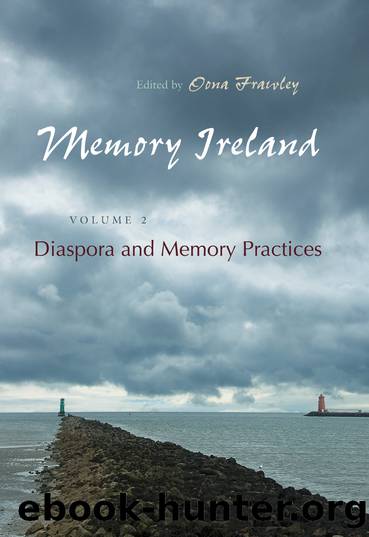Memory Ireland by Frawley Oona;

Author:Frawley, Oona;
Language: eng
Format: epub
Publisher: Syracuse University Press
Published: 2017-12-09T00:00:00+00:00
It is a deliberately intended allegory to see the âcracked lookingglass of a servantâ (U 1.146) as representing the condition of Ireland in 1904. That condition has in turn often been seen as one of cultural discontinuityâthe demise of Gaelic during and following the Famine constituting as crack in the mirror, as it were (Leerssen 1988; Cronin 1998; Tymoczko and Ireland 2003). Thus Thomas Kinsella in his essay âThe Irish Writerâ encounters a âgreat cultural blurâ when he looks for âthe past in [him]selfâ: âI must exchange one language for another, my native English for eighteenth-century Irishâ (1970, 58). Kinsella sees this bifurcation in his cultural memory as if he comes, âso to speak, from a broken and uprooted family, [in] being drawn to those who share my origins and finding that we cannot share our livesâ (59). John Montagueâs lines in âA Severed Headâ (part of the celebrated cycle The Rough Field) have, for all their clumsy ineptness, become an aureum dictum: âTo grow / a second tongue, as / harsh a humiliation / as twice to be bornâ (1972, ll. 33â36); and Brian Frielâs Translations remains, despite its willfully counterfactual distortion of cultural change in nineteenth-century Ireland, accepted as a valid âpoeticâ representation and interpretation of real-world events.6
That, then, is the wider allegorical meaning of the cracked mirror: language change as a traumatic, self-alienating disruption, a fracture in the historical, transgenerational course of cultural transmission. The process set in with Tudor wars and the Flight of the Earls and reached its nadir in the Famine of the midânineteenth century and the subsequent pattern of emigrationâthat is to say: in the immediate historical run-up to Bloomsday. The nineteenth century out of which Ulysses emerges has been described by Robert Welch as âthat most intriguing and haunting of all phases of Irish culture . . . in which the great mass of Irish people moved from one language to another, from Gaelic to Englishâ (1988, x).
To be sure, the sense of a traumatic language shift in the previous generations is stronger in Dubliners than in Ulysses. Dubliners has the mantra of a no-longer-understood Gaelic phrase, derevaun seraun, spoken as the dying words of the mother of Eveline (in the story of that title)âalmost like an abracadabra that will conjure up the ghost of Michael Furey in âThe Dead,â where the unquiet grave of Irish is also troubled by the feisty but vaguely disconcerting revivalism of Miss Ivors.
Such references are far less prominent in Ulysses, where the only interest in Irish is shown by the English tourist Haines, in the âTelemachusâ episode; even the old woman who delivers milk to the Martello Tower is, in a deflation of Hainesâs fondly exoticist expectations, off-handed and ignorant of the language. Ironically, the only one in the book who would gratify Hainesâs English Gaelophilia would be the grotesquely nativist Citizen, he of the âCyclopsâ episode. There is more Greek than Gaelic in Ulysses, which after all sets out to âHellenizeâ Ireland. The main presiding spirit is that of Odysseus, not St.
Download
This site does not store any files on its server. We only index and link to content provided by other sites. Please contact the content providers to delete copyright contents if any and email us, we'll remove relevant links or contents immediately.
Room 212 by Kate Stewart(4703)
The Crown by Robert Lacey(4549)
Endurance: Shackleton's Incredible Voyage by Alfred Lansing(4456)
The Iron Duke by The Iron Duke(4089)
The Rape of Nanking by Iris Chang(3994)
Killing England by Bill O'Reilly(3883)
Joan of Arc by Mary Gordon(3756)
Say Nothing by Patrick Radden Keefe(3677)
I'll Give You the Sun by Jandy Nelson(3237)
Shadow of Night by Deborah Harkness(3154)
Hitler's Monsters by Eric Kurlander(3132)
Blood and Sand by Alex Von Tunzelmann(3031)
Mary, Queen of Scots, and the Murder of Lord Darnley by Alison Weir(3015)
Darkest Hour by Anthony McCarten(2997)
Margaret Thatcher: The Autobiography by Thatcher Margaret(2952)
Eleanor & Park by Rainbow Rowell(2913)
Red Famine: Stalin's War on Ukraine by Anne Applebaum(2799)
Book of Life by Deborah Harkness(2696)
The One Memory of Flora Banks by Emily Barr(2664)
